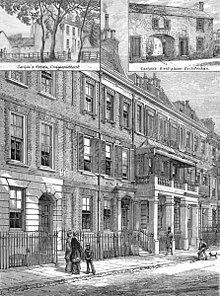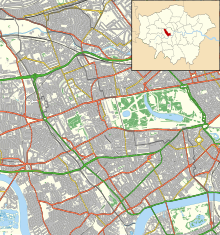Carlyle's House

The house in 1881
|
|
| Location | Cheyne Row London, SW3 United Kingdom |
|---|---|
| Coordinates | 51°29′3.48″N 0°10′12″W / 51.4843000°N 0.17000°WCoordinates: 51°29′3.48″N 0°10′12″W / 51.4843000°N 0.17000°W |
| Type | Historic house museum |
| Owner | National Trust |
| Public transit access |
|
| Nearest parking | Limited metered street parking |
| Website | www |
|
Listed Building – Grade II*
|
|
| Designated | 24 June 1954 |
| Reference no. | 1358142 |
| Building type | Georgian terraced house |
| Open: Yearly | March–October |
| Open: Weekly | Wednesday-Sunday and Bank Holiday Mondays |
Carlyle's House, in the district of Chelsea, in central London, England, was the home acquired by the historian and philosopher Thomas Carlyle and his wife Jane Welsh Carlyle, after having lived at in Dumfriesshire, Scotland. She was a prominent woman of letters, for nearly half a century. The building dates from 1708 and is at No. 24 Cheyne Row (No. 5 at Carlyle's time); the house is now owned by the National Trust.
The house is a typical Georgian terraced house, a modestly comfortable home where the Carlyles lived with one servant and Jane's dog, Nero. The house was opened to the public in 1895, just fourteen years after Carlyle's death. It is preserved very much as it was when the Carlyles lived there despite another resident moving in after them with her scores of cats and dogs. It is a good example of a middle class Victorian home due to the efforts of devotees tracking down much of the original furniture owned by the Carlyles. It contains some of the Carlyles' books (many on permanent loan from the London Library, which was established by Carlyle), pictures and personal possessions, together with collections of portraits by artist such as James Abbott McNeill Whistler and Helen Allingham and memorabilia assembled by their admirers.
The house is made up of four floors — a basement which houses the kitchen, the ground floor which was the Carlyles' parlour, the first floor where the drawing room/library and Jane's bedroom are found, the second floor which was Thomas' bedroom and is now the Custodian's residence, and the attic, which was converted into a study in an attempt to remove Carlyle from the constant noise of the street and neighbours. It has a small walled garden which is preserved much as it was when Thomas and Jane lived there — the fig tree still produces fruit today.
Theatre producer Stanford Holme became curator of the house and moved there with his wife, the actress Thea Holme in 1959. She took up writing, beginning with a book about the lives of Thomas and Jane Carlyle at the house, The Carlyles at Home (1965).
...
Wikipedia

